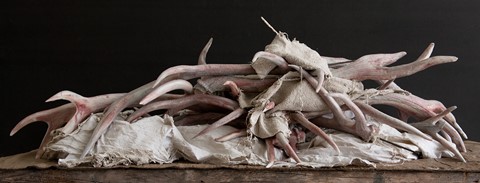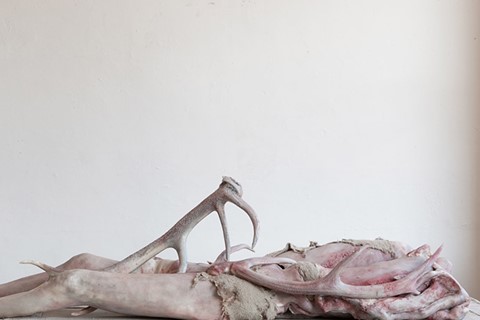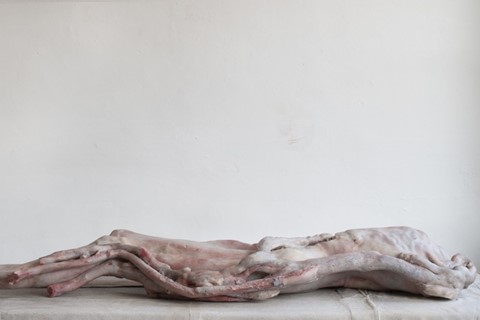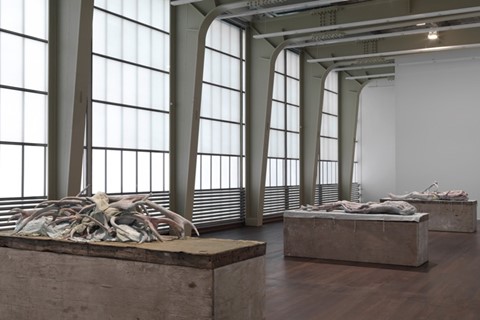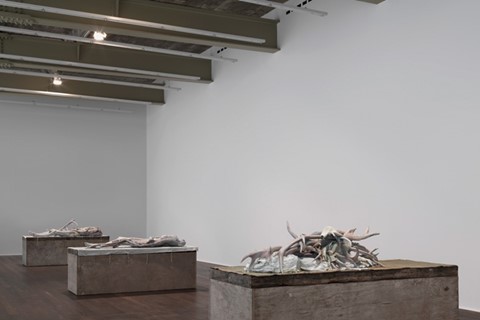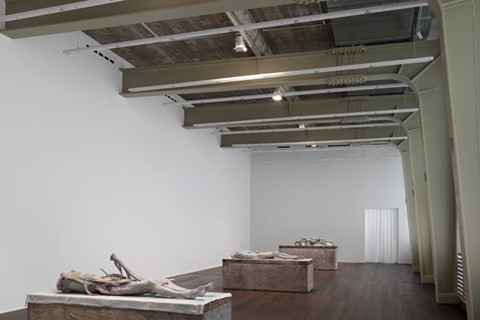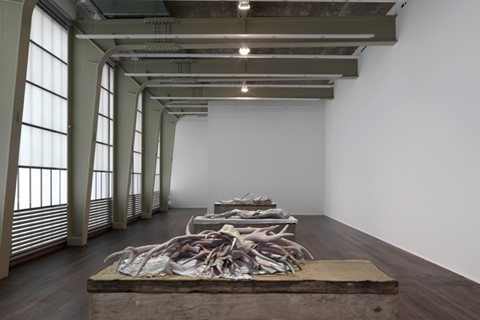For those that have ever encountered one of Berlinde De Bruyckere sculptures, one may understand this perpetual feeling of anxiety that the artist ignites. It is a feeling that exists in the subtle contradictions of her work...
For those that have ever encountered one of Berlinde De Bruyckere sculptures, one may understand this perpetual feeling of anxiety that the artist ignites. It is a feeling that exists in the subtle contradictions of her work. Where flesh is not simply flesh and vulnerability is allowed to coexists with the weighty brutality of her figures. Torsos are left to hang from the celling, mounted against walls of a gallery or sprawled out over a wooden plinth. Up close, you begin to encounter the painterly qualities of her work. Flesh becomes its own surface, covered in veins and made up of a haunting colour palette of blues, greens and yellows. "When I paint with my wax, it is like making a watercolour drawing," she explains, a means to bring life into the surface texture of her sculptures. Berlinde lives and works in Ghent. Occupying a former catholic school for boys where the building itself has been transformed into large studios, allowing her to bring back bodies from the local university or hospital to use as her models. In her current exhibition at Hauser & Wirth in Zurich, Berlinde has taken Ovid's Metamorphoses and created a series of three new works, where antlers emerge from the human figure, deforming it and creating a strange new hybrid form. With this in mind, AnOther spoke to Berlinde about her fascination with flesh, her interest in the works of the Old Masters and her exhibition in Zurich.
Your father was a butcher, did that have a influence on you whilst you were growing up?
I have been thinking about this a lot over the last year and I think what I do is completely the opposite of what my father did. He was cutting dead animals into pieces to sell it, for people to eat. I do something very different. I take a dead body from the slaughter house or from the university and bring it into my workshop, then I do all the modelling on the actual figure. It is as if I give the body a new life, so they can exist again because they have become a sculpture. I began asking myself what the most important thing was that I took from growing up surrounded by the dead animals and huge carcasses that I saw as a child. I think is it that I am not afraid of dead bodies. I am used to seeing them. When I first take my assistants with me to the university or the hospital they are afraid because they are not used to seeing dead bodies, especially not in fridges or the situations in which we have to work with them. For me, it was part of my childhood. I think this is the only link that I can make between being the daughter of a butcher.
"I take a dead body from the slaughter house or from the university and bring it into my workshop, then I do all the modelling on the actual figures"
What interests you about flesh?
When I started to work with the bodies, it was a very long process. In the beginning, during the 90s, I was working with the blanket women, so they had only exposed legs and feet. The rest of their body was covered by blankets. These works were all about longing for shelter and the blanket became a way to remove yourself from reality. To be hidden and have your own space. At that point, I was not interested in flesh. I was more interested in integrating the human figure in my work and it started very slowly and then it became more important. I transformed the blankets into a body and they held the shape of a torso in the further stage of my research. Then at the end I took away the blankets and I kept the formation of the body that was underneath. I started to work like this. It was not something that I decided by myself, it was something that was growing from one work into another and it ended up with a very naked or vulnerable way of expressing a human body.
Something that has always left me feeling both uncomfortable and intrigued, is the translucency you achieve when representing skin...
In the beginning I was not so interested in the pictorial qualities of of using the wax. However, for the last five years I have been researching old master paintings and looking at how they paint the skin of naked figures. I was looking at Caravaggio and to all of these medieval paintings just to learn how they did it. How they captured the transparency and translucency of the skin – that was something that took my attention. Then I tried to find my own way to translate this into my own sculptures and now I feel like they are half painting and half sculpture. When I paint with my wax, it is like making a watercolour drawing because all these layers are melting together and they give you surface. Surface is what you see when you look at the work and what takes your attention. Now, very often it becomes very brutal. If you look at the sculptures in Zurich, some parts are very yellow, or green, or blue, or red. For me it gives the figure life again.
Do you consider your work to be romantic?
It depends what you consider to be romantic. For me, yes. It is romantic because if we talk about beauty and especially aesthetics, I feel myself to be very aesthetic. Even when I use always old furniture, textiles and used materials, there was a beauty in that for me because these objects had a history. Very often I feel like I am working with the idea of curation. I collect a lot of plinths and branches, then at a certain moment I bring them into the studio to become part of a sculpture. It is not that they aren't objects on their own, or that I first make my sculpture and then afterwards I put them on a plinth. For me these special objects become a starting point to work on top of. In one way it is romantic.
This notion of transformation and deformation has continued to develop throughout your career, is that something that continues to interest you?
Yes. This can be found If you look at the two sculptures of the bodies in the Zurich show. One is a very strong figure with the huge legs, the other one is more like the female side of the body, even though it is made out of a male it is much more tender and fragile. Also, the way that the body is empty is something that is very important. There is a huge hole in his stomach and it is showing you that it is not something real, but that it is a sculpture. A hole is something that grabs your attention and it makes you very curious to uncover what is inside. In this case, you see the antlers inside. These black holes play a very important part in all my works. It is like when you have a doll as a child and you take away a arm or leg and what you can see inside is simply a black hole. It is only a doll, it is not real. I think it is very important for me that I can always play with this feeling that it is about sculpture and my work. It is not about reality, even thought that where it started from. I always mould on the real figure and if I work on a tree or a deer, or man or women, I use the real body to start with. This is my occupation as a starting point, then I have to go over it to translate it to my own language.
"Even when I use always old furniture, textiles and used materials, there was a beauty in that for me because these objects had a history"
Can you talk about the three new sculptures at Hauser & Wirth in relation to Ovid's Metamorphoses?
Yes, the idea for this group of works came after reading the Ovid's Metamorphoses. In the story, Actæon was transformed into a deer, eaten by his own dogs and in the end there was nothing left of him. In my imagination, there were only the antlers left. So I placed a group of antlers on a plinth and that almost took on a sort of portrait of Actæon after his death. They are made out of wax and are very fragile. I wanted to have a soft material against the hard and heavy shape of the antlers, so I placed bits of fabrics and textiles in between. The way that they are laying on the plinth is almost like when you cut down the bad branches from a tree because they are dry or dead. You collect them together and put them into fire. It is like you want to destroy the work, and this was something that was constantly in my mind. The antlers are the way a deer can seduce a whole forest. It is something that is very strong and beautiful, an expression of power and sexuality in one way. Then on the other hand it is something that can destroy you because you have too much desire and too much longing for something that you can't have. That is the thing that destroys you. They are made out of wax so they can burn easily, if they were put in fire they would be gone. It would all be over.
In the other two figures, Liggende I & II, you have a very explicit image of the antlers growing out, or into the body. You have this inner relation between the antler and the body, so that there is no torso anymore. The torso becomes a very abstract form, something completely deformed. It is the antlers that take over the shape of the body. They became much stronger and then destroyed Actæon's own body. On the other hand, when they grow into the body it becomes part of them. It is not something that you can cut off. In reality, the antlers fall off from the deer's body and then they start growing over again. The antlers are growing into their own body, so you cant remove it any more. It is like a memory of something that happens to you in your personal life that you cant throw away, but it is always there even if you don't want it anymore, it becomes part of you.
How important is process in your work? I imagine the materials you use and they way you sculpt them demand a lot from you physically and in terms of space.
I never work on one sculpture from the beginning until the end. I have a huge studio and I am working on different themes and pieces at the same time. I have one part of the studio, where I work on horse pieces, another where I do the figures and then when we are working on trees we have a bigger space. So, I have my way to escape from one thing. The moments where I struggle or cant continue because of mental reasons or I cant find a solution to finish the work, there is always another way to escape.
Berlinde De Bruyckere's Three Sculptures at Hauser & Wirth Zurich until December 22, 2012
Text by Isabella Burley
